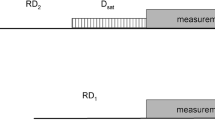Abstract
An “almost diagonal” reduced density matrix (in coordinate representation) is usually a result of environment induced decherence and is considered the sign of classical behavior. We show that the proton of a ground state hydrogen atom can indeed possess such a density matrix. This example demonstrates that the “almost diagonal” structure may be derived from an interaction with a low number of degrees of freedom which play the role of the environment. We also show that decoherence effects in our example can only be observed if the interaction with the measuring device is significantly faster than the interaction with the environment (the electron). In the opposite case, when the interaction with the environment is significant during the measurement process, coherence is maintained. Finally, we propose a neutron scattering experiment on cold He atoms to observe decoherence which shows up as an additional positive contribution to the differential scattering cross section. This contribution is inversely proportional to the bombarding energy.
Similar content being viewed by others
References
D. Giuliani, E. Joos, C. Kiefer, J. Kupsch, I.-O. Stamatescu, H.D. Zeh: Decoherence and the Appearence of a Classical World, Springer, New-York, Heidelberg, Berlin, 1995 and references therein.
J.P. Paz and W.H. Zurek: “Environment-induced Decoherence and the Transition from Quantum to Classical”, Course lectures at the 72nd Les Houches Summer School on “Coherent Matter Waves”, July–August, 1999, http://xxx.lanl.gov/quantph/0010011.
E. Schrödinger: “Discussion of Probability Relations Between Separated Systems I”, Proceedings of the Cambridge Philosophical Society, Vol. 31, (1935), pp. 555–563. E. Schrödinger: “Discussion of Probability Relations Between Separated Systems II”, Proceedings of the Cambridge Philosophical Society, Vol. 32, (1936), pp. 446–451.
E. Schmidt: Math. Annalen, Vol. 63, (1907), pp. 433. A.C. Zaanen: Linear Analysis, North Holland, Amsterdam, 1960, pp. 432–440. O. Kübler and H.D. Zeh: “Dynamics of Quantum Correlations”, Ann. Phys. (NY), Vol. 76, (1973), pp. 405.
W.H. Zurek: “Pointer basis of quantum apparatus: Into what mixture does the wave packet collapse?”, Phys. Rev. D, Vol. 24, (1981), pp. 1516–1524. A.O. Caldeira and A.J. Leggett: “Path Intergral Approach to Quantum Brownian Motion”, Physica A, Vol. 121, (1983), pp. 587–616.
E. Joos and H.D. Zeh: “The Emergence of Classical Properties Through Interaction with the Environment”, Z. Phys. B, Vol. 59, (1985), pp. 223.
G. Bene: Representation-free upper bound for the width of a density matrix, 2003, unpublished.
M. Born and J.R. Oppenheimer: “Zur Quantentheorie der Molekeln”, Ann. Physik (Leipzig), Vol. 84, 1927, pp. 457–484.
C.S. Adams, M. Sigel, J. Mlynek: “Atom optics”, Phys. Rep., Vol. 240, 1994, pp. 143–210 and references therein.
J. Franck: Trans. Faraday Soc., Vol. 21, (1925), pp. 536. E.U. Condon: “Nuclear Motions Associated with Electron Transitions in Diatomic Molecules”, Phys. Rev., Vol. 32 (1928), pp. 858–872. E.U. Condon: “Production of Infrared Spectra with Electric Fields”, Phys. Rev., Vol. 41, (1932), pp. 759–762.
E. Santos: “Objectification of classical properties induced by quantum vacuum fluctuations”, Phys. Lett. A, Vol. 188, (1994), pp. 198.
L. Diósi: Comments on “Objectification of classical properties induced by quantum vacuum fluctuations”, Phys. Lett. A, Vol. 197, (1995) pp. 183–184.
Author information
Authors and Affiliations
About this article
Cite this article
Bene, G. Decoherence within a single atom. centr.eur.j.phys. 1, 332–343 (2003). https://doi.org/10.2478/BF02476300
Received:
Revised:
Issue Date:
DOI: https://doi.org/10.2478/BF02476300




